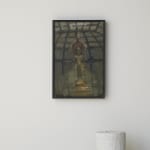Sugimoto Kenkichi (1905−2004)
Kannon
Oil on paper, framed
With a label signed by the artist
Seal: Sugi
39.5 x 26 cm
41 x 27.5 cm (overall)
Further images
In a dimly lit exhibition hall with an obscure face, the statue of Kannon stands solemnly. The entirety is shrouded in a veil of halation, implying that it is exhibited in a glass case. Perhaps it is the sun shedding light on the feet of Kannon, or just a shadow of the viewer being cast on the case, resulting in a brighter effect towards the lower center of the painting.
Sugimoto Kenkichi devoted his life to producing a series of paintings of Buddhist temples and statues, as well as sceneries in Nara on account of his thorough fascination with the complicated effects caused by light and space at Imperial Nara Museum (nowadays, Nara National Museum). Since 1942 he visited Nara back and forth, working on the subject with relation to the scenes in a display room. His work, Center of the Museum, was given a special prize at the fifth Shin bunten, or the New ministry of education art exhibition, in 1944.
Back to the present work, the glass case, the light, and the shadow reflected in the surface are intentionally sketched. Not only does Sugimoto depict the statue in sight, but he also carefully observes its surroundings such as the depth of space and the presence of people, representing those details in the work. Through this painting, the viewer might encounter what Sugimoto had experienced in the midst of the silent exhibition hall.
Sugimoto Kenkichi (yoga painter; 1905−2004)
Aichi-born yoga painter. Studied under Kishida Ryusei in Kyoto. Favored to depict sceneries, Buddhist temples and statues in Nara. Received tokusen (special prize that grants entry without examination in the following year) at Bunten and Teiten. Also known as a book illustrator. His illustrations in Shin heike monogatari, the novel written by Yoshikawa Eiji, are particularly well-known. Member of Kokuga-kai; later resigned and worked independently.
Sugimoto Kenkichi devoted his life to producing a series of paintings of Buddhist temples and statues, as well as sceneries in Nara on account of his thorough fascination with the complicated effects caused by light and space at Imperial Nara Museum (nowadays, Nara National Museum). Since 1942 he visited Nara back and forth, working on the subject with relation to the scenes in a display room. His work, Center of the Museum, was given a special prize at the fifth Shin bunten, or the New ministry of education art exhibition, in 1944.
Back to the present work, the glass case, the light, and the shadow reflected in the surface are intentionally sketched. Not only does Sugimoto depict the statue in sight, but he also carefully observes its surroundings such as the depth of space and the presence of people, representing those details in the work. Through this painting, the viewer might encounter what Sugimoto had experienced in the midst of the silent exhibition hall.
Sugimoto Kenkichi (yoga painter; 1905−2004)
Aichi-born yoga painter. Studied under Kishida Ryusei in Kyoto. Favored to depict sceneries, Buddhist temples and statues in Nara. Received tokusen (special prize that grants entry without examination in the following year) at Bunten and Teiten. Also known as a book illustrator. His illustrations in Shin heike monogatari, the novel written by Yoshikawa Eiji, are particularly well-known. Member of Kokuga-kai; later resigned and worked independently.







